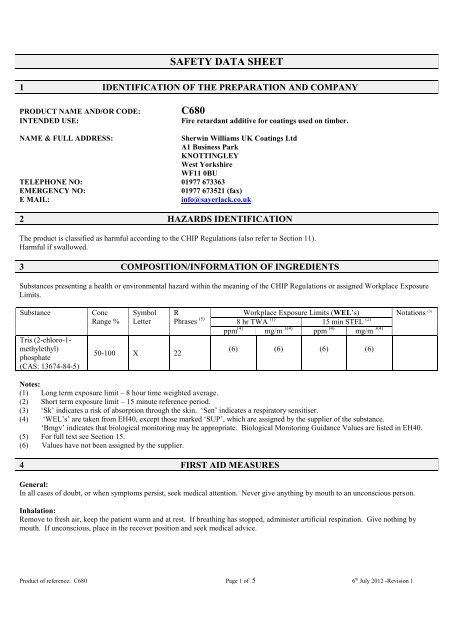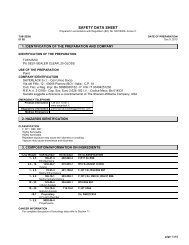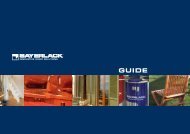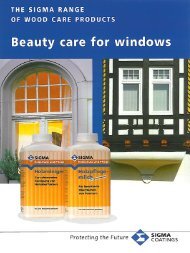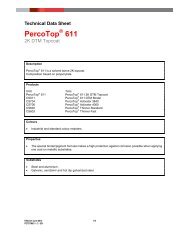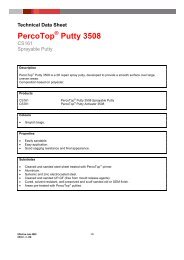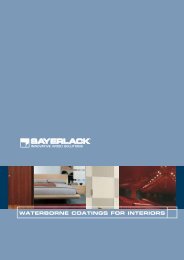Material Safety Data Sheet - Movac Group Limited
Material Safety Data Sheet - Movac Group Limited
Material Safety Data Sheet - Movac Group Limited
Create successful ePaper yourself
Turn your PDF publications into a flip-book with our unique Google optimized e-Paper software.
SAFETY DATA SHEET<br />
1 IDENTIFICATION OF THE PREPARATION AND COMPANY<br />
PRODUCT NAME AND/OR CODE:<br />
INTENDED USE:<br />
C680<br />
Fire retardant additive for coatings used on timber.<br />
NAME & FULL ADDRESS:<br />
Sherwin Williams UK Coatings Ltd<br />
A1 Business Park<br />
KNOTTINGLEY<br />
West Yorkshire<br />
WF11 0BU<br />
TELEPHONE NO: 01977 673363<br />
EMERGENCY NO:<br />
01977 673521 (fax)<br />
E MAIL:<br />
info@sayerlack.co.uk<br />
2 HAZARDS IDENTIFICATION<br />
The product is classified as harmful according to the CHIP Regulations (also refer to Section 11).<br />
Harmful if swallowed.<br />
3 COMPOSITION/INFORMATION OF INGREDIENTS<br />
Substances presenting a health or environmental hazard within the meaning of the CHIP Regulations or assigned Workplace Exposure<br />
Limits.<br />
Substance<br />
Tris (2-chloro-1-<br />
methylethyl)<br />
phosphate<br />
(CAS: 13674-84-5)<br />
Conc<br />
Range %<br />
Symbol<br />
Letter<br />
50-100 X 22<br />
R<br />
Workplace Exposure Limits (WEL’s) Notations (3)<br />
Phrases (5) 8 hr TWA (1) 15 min STEL (2)<br />
ppm (4) mg/m 3(4) ppm (4) mg/m 3(4)<br />
(6) (6) (6) (6)<br />
Notes:<br />
(1) Long term exposure limit – 8 hour time weighted average.<br />
(2) Short term exposure limit – 15 minute reference period.<br />
(3) ‘Sk’ indicates a risk of absorption through the skin. ‘Sen’ indicates a respiratory sensitiser.<br />
(4) ‘WEL’s’ are taken from EH40, except those marked ‘SUP’, which are assigned by the supplier of the substance.<br />
‘Bmgv’ indicates that biological monitoring may be appropriate. Biological Monitoring Guidance Values are listed in EH40.<br />
(5) For full text see Section 15.<br />
(6) Values have not been assigned by the supplier.<br />
4 FIRST AID MEASURES<br />
General:<br />
In all cases of doubt, or when symptoms persist, seek medical attention. Never give anything by mouth to an unconscious person.<br />
Inhalation:<br />
Remove to fresh air, keep the patient warm and at rest. If breathing has stopped, administer artificial respiration. Give nothing by<br />
mouth. If unconscious, place in the recover position and seek medical advice.<br />
Product of reference: C680 Page 1 of 5 6 th July 2012 -Revision 1
Eye Contact:<br />
Contact lenses should be removed. Irrigate copiously with clean, fresh water for at least 10 minutes, holding eyelids apart and seek<br />
medical advice.<br />
Skin Contact:<br />
Remove contaminated clothing. Wash skin thoroughly with soap and water or use a proprietary skin cleaner.<br />
DO NOT USE SOLVENTS OR THINNERS.<br />
Ingestion:<br />
If accidentally swallowed obtain immediate medical attention. Keep at rest. Do NOT induce vomiting.<br />
5 FIRE FIGHTING MEASURES<br />
Extinguishing Media:<br />
RECOMMENDED:<br />
NOT TO BE USED:<br />
Alcohol resistant foam, CO 2 powder, water spray/mist<br />
Water jet<br />
Recommendations:<br />
Fire will produce dense black smoke containing hazardous products of combustion (see Section 10). Exposure to decomposition<br />
products may be a hazard to health. Appropriate self-contained breathing apparatus may be required. Cool closed containers exposed<br />
to fire with water spray. Do not allow run-off from fire fighting to enter drains or watercourses.<br />
6 ACCIDENTAL RELEASE MEASURES<br />
Exclude sources of ignition and ventilate the area. Exclude non-essential personnel. Avoid breathing vapours. Refer to protective<br />
measures listed in Sections 7 and 8. Contain and collect spillages with non-combustible absorbent materials, e.g. sand, earth,<br />
vermiculite, diatomaceous earth and place in a suitable container for disposal in accordance with the waste regulations (see Section 13).<br />
Do not allow to enter drains or watercourses. Clean preferably with a detergent and avoid the use of solvents.<br />
If the product enters drains or sewers the local Water Company should be contacted immediately; in case of contamination of streams,<br />
rivers or lakes, the relevant environment agency.<br />
7 HANDLING AND STORAGE<br />
Handling:<br />
Prevent air-borne concentrations higher than the workplace exposure limits.<br />
Keep the container tightly closed. Exclude sources of heat, sparks and open flame.<br />
Avoid skin and eye contact. Avoid inhalation of vapour and spray mist.<br />
Smoking, eating and drinking should be prohibited in areas of storage and use.<br />
For Occupational Exposure Controls see Section 8.<br />
Never use pressure to empty: The container is not a pressure vessel.<br />
Always keep in containers made of the same material as the supply container.<br />
Good housekeeping standards including the regular safe removal of waste materials and regular maintenance of spray booth filters will<br />
minimise fire hazards.<br />
The Manual Handling Operations Regulations may apply to the handling of containers of the product. Refer to the guide weight<br />
indicated on the container when carrying out assessments.<br />
Storage:<br />
Product us hygroscopic (absorbs moisture) and should be stored in sealed moisture free containers.<br />
Observe the label precautions. Store between 5 and 25ºC in a dry, well-ventilated place, away from sources of heat, ignition and direct<br />
sunlight. No smoking. Prevent unauthorised access. Containers that are opened should be properly resealed and kept upright to<br />
prevent leakage. Store separately from oxidising agents and strongly alkaline and strongly acidic materials.<br />
Product of reference: C680 Page 2 of 5 6 th July 2012 -Revision 1
8 EXPOSURE CONTROLS/PERSONAL PROTECTION<br />
Exposure Limits:<br />
(see Section 3).<br />
Exposure Controls:<br />
Provide adequate ventilation. Where reasonably practicable this should be achieved by the use of local exhaust ventilation and good<br />
general extraction. If these are not sufficient to maintain concentrations of particulates below the relevant workplace exposure limits,<br />
suitable respiratory protective equipment should be worn (see Personal Protection below).<br />
Personal Protection:<br />
All personal protective equipment, including respiratory protective equipment, used to control exposure to hazardous<br />
substances must be selected to meet the requirements of the COSHH Regulations.<br />
Respiratory Protection:<br />
Local exhaust ventilation and good general extraction should be used to control any build up of airborne material.<br />
Hand Protection:<br />
When skin exposure may occur, advice should be sought from glove suppliers on appropriate types and usage times for this product.<br />
The instructions and information provided by the glove supplier on use, storage, maintenance and replacement must be followed.<br />
Barrier creams may help to protect exposed areas of the skin, but are not substitutes for full physical protection. They should not be<br />
applied once exposure has occurred.<br />
Eye Protection:<br />
Eye protection designed to protect against liquid splashes should be worn.<br />
Skin Protection:<br />
Cotton or cotton/synthetic overalls or coveralls are normally suitable. Grossly contaminated clothing should be removed and the skin<br />
washed with soap and water or a proprietary skin cleaner.<br />
Regular skin inspection of users of this product is recommended.<br />
ALWAYS WASH YOUR HANDS BEFORE EATING, SMOKING OR USING THE TOILET.<br />
9 PHYSICAL AND CHEMICAL PROPERTIES<br />
Physical state:<br />
Liquid<br />
Flash Point:<br />
Not below its decomposition temperature<br />
Viscosity: 65 cps Method: Brookfield at 25ºC<br />
Specific Gravity: 1.29 Method: weight of 100 ml at 20ºC<br />
Vapour Density (air=1):<br />
Not Determined<br />
Lower Explosion Limit:<br />
Not Determined<br />
Boiling Point (ºC):<br />
Not Determined<br />
Solubility in Water:<br />
Insoluble<br />
VOC g/L 0<br />
10 STABILITY AND REACTIVITY<br />
Stable under the recommended storage and handling conditions (see Section 7). In a fire, hazardous decomposition products such as<br />
smoke, carbon monoxide and carbon dioxide and oxides of nitrogen may be produced.<br />
Keep away from oxidising agents and strongly alkaline and strongly acidic materials to prevent the possibility of exothermic reaction.<br />
Product of reference: C680 Page 3 of 5 6 th July 2012 -Revision 1
11 TOXICOLOGICAL INFORMATION<br />
Acute oral LD 50 (Rat) > 2000mg/Kg.<br />
Limit test – some mortalities at this dose. Literature values for Rat opral tocicitiy range beteen 1000 – 2500 mg/Kg.<br />
May cause some irritation of the mouth and upper digestive tract. Ingestion of large quantities may cause systemic effects.<br />
Acute dermal toxicity LD 50 (Rat) > 7.9mg/l<br />
May cause skinirritation if exposure is prolonged or repeated.<br />
Eye: Not classified as an irritant when tested in the rabbit.<br />
Inhalation: LC 50 (Rat) > 7.19 mg/l<br />
May irritate the nose and upper respiratory tract.<br />
Mutagenicity: Negative in in vitro and in vivo tests.<br />
12 ECOLOGICAL INFORMATION<br />
Aquatic toxicity:<br />
Chronic Study – Daphnia :<br />
Biodegradation :<br />
LC 50 84 ppm (96 hr; Bluegill Sunfish)<br />
LC 50 51 ppm (96 hr; Fathead Minnow)<br />
LC 50 131 mg/l (48 hr; Daphnia magna)<br />
21 day EC 50 (Immobilisation) parental = 40 mg/l<br />
21 day EC 50 (Reproduction) between 32 and 56 mg/l<br />
NOEC 32 mg/l<br />
Not expected to be readily biodegradable.<br />
Inherent Biodegradability study (Modified MITI):<br />
21% degradation after 28 days, therefore, this product may be considered to be inherently biodegradable.<br />
Air Pollution Control requirements of regulations made under the Environmental Protection Act and Pollution Prevention and Control<br />
Act may apply to the use of this product (see Section 9 for VOC level).<br />
13 DISPOSAL CONSIDERATIONS<br />
Do not allow into drains or watercourses or dispose of where ground or surface waters may be affected. Wastes, including emptied<br />
containers, are controlled wastes and should be disposed of in accordance with regulations made under the Control of Pollution Act and<br />
the Environmental Protection Act.<br />
Using the information provided in this safety data sheet, advice should be obtained from the relevant environment agency, whether the<br />
special waste regulations apply.<br />
14 TRANSPORT INFORMATION<br />
The product is not classified as dangerous for carriage.<br />
Transport within the user’s premises:<br />
Always transport in closed containers that are upright and secure.<br />
Ensure that persons transporting the product know what to do in the event of accident or spillage.<br />
Product of reference: C680 Page 4 of 5 6 th July 2012 -Revision 1
15 REGULATORY INFORMATION<br />
This product is determined as not being dangerous according to the CHIP Regulations.<br />
R No<br />
R22<br />
S No<br />
S46<br />
S2<br />
S23<br />
S51<br />
Phrase<br />
HARMFUL IF SWALLOWED<br />
Phrase<br />
IF SWALLOWED SEEK MEDICAL ADVICE IMMEDIATELY AND SHOW THIS<br />
CONTAINER OR LABEL.<br />
KEEP OUT OF REACH OF CHILDREN<br />
DO NOT BREATHE VAPOUR/SPRAY<br />
USE ONLY IN WELL VENTILATED AREAS<br />
The information contained in this safety data sheet does not constitute the user’s own assessment of workplace risks as required by<br />
other health and safety legislation. The provisions of the Health and <strong>Safety</strong> at Work etc Act and the Control of Substances Hazardous<br />
to Health Regulations apply to the use of this product at work.<br />
16 OTHER INFORMATION<br />
The information contained in this safety data sheet is provided in accordance with the requirements of CHIP Regulations.<br />
The product should not be used for purposes other than those shown in Section 1 without first referring to the supplier and obtaining<br />
written handling instructions. As the specific conditions of use of the product are outside the supplier’s control, the user is responsible<br />
for ensuring that the requirements of relevant legislation are complied with.<br />
The information contained in this safety data sheet is based on the present state of knowledge and current national legislation. It<br />
provides guidance on health, safety and environmental aspects of the product and should not be construed as any guarantee of technical<br />
performance or suitability for particular applications.<br />
Further information and relevant advice can be found in the following:<br />
The Control of Substances Hazardous to Health Regulations 2002 (SI 2002: 2677)<br />
COSHH Essentials: easy steps to control chemicals, HSG193<br />
The Manual Handling Operations Regulations 1992 (SI 1992: 2793)<br />
The Environmental Protection (Duty of Care) Regulations 1992 (SI 1992: 2839)<br />
EH40/## Occupational Exposure Limits – HSE Books<br />
A Guide to Working with Solvents, INDG 272<br />
HSE website www.hse.gov.uk<br />
Product of reference: C680 Page 5 of 5 6 th July 2012 -Revision 1


